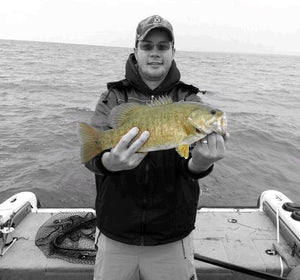Have you ever heard the story of how the fishing spoon was invented? Long before the most notorious style of lure was ever a patent, it was discovered. Discovered being a most accurate way to describe what happened really. As the story goes, as with most great things the fishing spoon was completely an accident.
It wasn’t a trout, or walleye or pike, not even a salmon made the discovery of the fishing spoon possible. The species of fish that made the fishing spoon the most prolific lure of all time, was of course, a giant, Hangry-ass Bass.
As of this writing, Wikipedia (https://en.wikipedia.org/wiki/Bass_fishing), would have you believe that the Bass fishing story beings “In the mid-19th century.” The incorrect claim is made that the fly was “the first artificial lure used for bass [fishing].” The site (Yes, we understand it’s open-source and we could recommend a historical revision, and we may) also credits balsa wood plugs and poppers emerging at or around 1900 as well as the production of the plastic worms beginning in 1949. Then, in the 1960’s the claim is “the plastic worm revolutionized the sport of bass fishing.”
Our story told here today, the real story, begins much earlier. Our story of how bass fishing came to be, starts in 1827 and decades before the first Salmon flies (river flies) were ever known to have been co-opted and retrofitted to attract members of the Bass family. Our tale begins when a young Julio T. Buel was out fishing and dropped his luncheon spoon in the drink. He watched as the soup spoon fluttered as it sank, expecting it to bottom-out in the silty bottom of the lake, when instead, a Hawg of a Bass swept by. With the flip of its tail and gulp of its beak, the spoon was gone.
It wasn’t the smell of beef barley broth that made the difference, rather, it was the flash of silver and wobble of the spoon that triggered a response. The Brute gobbled up Buel’s utensil and disappeared into the depths of the lake, not by mistake, but rather by instinct. The spoon resembled a wounded bait fish. Lucky for us young Buel wasn’t eating with a fork that day because what he witnessed would change the course of history for Bass enthusiasts as we know it.
In 1852 the spoon lure was officially invented. What we mean by this is Buel’s spoon inspired lure was officially registered by the US patent and trademark office. Buel’s own parents were relieved as they had long-since grown tired of their son cutting the handles from all their silverware. It was a few years prior to the issuance of the patent that Buel and his father opened their first manufacturing facility.
At the same time Buel had the foresight and marketing prowess to send his lures to writer Frank Forester. At the time, Frank (an influencer long before the phrase was created) was known for publishing weekly columns titled ‘Spirit of the Times.’ Buel would go on to invent and patent many more lures over the next 20+ years of his life. His company was purchased by Eppinger Manufacturing (Aka Dardevle) out of Dearborn, Michigan in 1967.
Whether or not Buel could have predicted what was yet to come in the evolution of the fishing spoon is anyone’s guess. Quite frankly it doesn’t matter. The fact is, the spoon remains to this day, the only lure you can successfully catch any target species, and in the widest variety of techniques: Troll, Cast, Pop, Pitch, Jig, or Flip. The spoon can do it all.
Technical Notes:
- We recommend always installing a hook so they’re oriented towards the center of the convex (unpainted/back) side of the lure.
- For single hooks this should be self explanatory.
- For treble hooks this means the one hook that is in-line with the solid loop of the eyelet (laying the lure ‘face down’ - meaning laying the concave/painted side down - the two hooks of the treble opposite the eyelet should sit flat with the split-ring straight up and down).
- We also recommend the following size hooks by spoon length.
- Length (in inches) Single Hook Treble Hook
- < 3.5” #1/0 #2 or #1
- >/= 3.5,” < 3.78” #2/0 #1 or #1/0
- 3.78 to 4.25” #3/0 #1/0
- > 4.25” #4/0 #1/0
- Treble Hooks Vs. Single Hooks:
- It really comes down to a matter of preference (Demographically, where you grew up and, Culturally, who you fish with will no doubt have the largest influence on this choice). We recommend fishing with both. Broaden your horizons and discover what works best for you in your body of water/s.
- Speaking Practicality:
- If catch and release is your sport, then we recommend a single hook and collapsing the barb with a pair of pliers.
- If the bite tends to be light, your hook-set to net time is short, and/or you’re not concerned with foul hook-sets, then a treble hook might be the way you want to go.
- If you're running long-lines trolling, or your fight times are consistently over the fifteen (15) minute mark, you may consider the larger, single, and barbed hook as your go to choice.
Happy fishing and Tight lines. Welcome to the Evolution,
Article written by Mike (Fish Mitts) Hiller

Picture courtesy of Gundawg Outdoors

